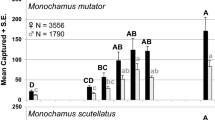Abstract
Catches of ants in the two most commonly-used forms of pitfall trap (‘test-tube’ traps, ca 18 mm diameter; ‘coffee cup’ traps, ca. 70 mm diameter) are compared from samples in open grassy woodland in southern Victoria, Australia. The 25 morphospecies found in the narrower traps were all represented among the 31 morphospecies collected in the larger traps. Either pattern is adequate to collect samples for broad inter-treatment comparisons and documentation of the more typical and representative fauna, but larger traps may have some advantage if more complete inventory is sought.
Similar content being viewed by others
References
M. Abensberg-Traun D. Steven (1995) ArticleTitleThe effects of pitfall trap diameters on ant species richness (Hymenoptera: Formicidae) and species composition of the catch in a semi-arid eucalypt woodland Aust. J. Ecol 20 282–287
D. Agosti L.E. Alonso (2000) The ALL protocol: a standard protocol for the collection of ground dwelling ants D. Agosti J.D. Majer L.E. Alonso T.R. Schultz (Eds) Ants. Standard Methods for Measuring and Monitoring Biodiversity Smithsonian Institution Press Washington, DC 204–206
A.N. Andersen (1991) The ants of southern Australia: a guide to the Bassian fauna CSIRO Publishing East Melbourne
B.T. Bestelmeyer D. Agosti L.E. Alonso C.R.F. Brandao W.L. Brown SuffixJr. J.H.C. Delabie R. Silvestre (2000) Field techniques for the study of ground-dwelling ants D. Agosti J.D. Majer L.E. Alonso T.R. Schultz (Eds) Ants. Standard methods for measuring and monitoring biodiversity Smithsonian Institution Press Washington, DC 122–144
K.E.C. Brennan J.D. Majer N. Reygaert (1999) ArticleTitleDetermination of an optimal pitfall tap size for sampling spiders in a Western Australian jarrah forest J. Insect Conserv 3 297–307 Occurrence Handle10.1023/A:1009682527012
T.T. Griffin C.M. Bull D.A. Mackay (2004) ArticleTitleThe effects of pitfall trap size and density on ant capture Rec. S. Aust. Mus 7 319–325
J.D. Majer (1978) ArticleTitleAn improved pitfall trap for the sampling of ants and other epigaeic invertebrates J. Aust. Entomol. Soc 17 261–262
C.L. Parr S.L. Chown (2001) ArticleTitleIndicator and bioindicator sampling: testing pitfall and Winkler methods with ants in a South African savanna J. Insect Conserv 5 27–36 Occurrence Handle10.1023/A:1011311418962
S.O. Shattuck (1999) Australian Ants: Their Biology and Identification CSIRO Publishing East Melbourne
Author information
Authors and Affiliations
Corresponding author
Rights and permissions
About this article
Cite this article
Borgelt, A., New, T. Pitfall trapping for ants (Hymenoptera, Formicidae) in mesic Australia: the influence of trap diameter. J Insect Conserv 9, 219–221 (2005). https://doi.org/10.1007/s10841-005-5172-8
Received:
Accepted:
Issue Date:
DOI: https://doi.org/10.1007/s10841-005-5172-8




